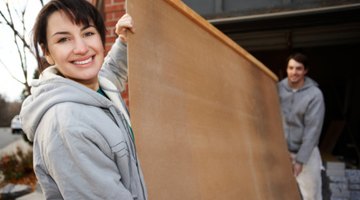How to Stain Pine Plywood
Pine plywood comes in large sheets and is often used in roofing and subfloor construction. The plywood gets its strength from multiple layers of pine veneer, each layer positioned at a right angle to the previous layer and tightly laminated to form a solid sheet.

Pine contains a high level of resin, which can cause uneven wood stain absorption if a sealer is not used.
Things You Will Need
- Pine sealer
- 220-sanding block
- Wood stain
- Paintbrush
- Absorbent rags
- Rubber gloves
- Splash-proof goggles
- Drop cloth
Tip
You can stain pine plywood to match the color of expensive hardwoods, such as walnut, mahogany, oak and cherry. Pine plywood comes in more than one grade. Use Grade A or B for constructing cabinets and furniture. Use a cheaper grade for roofing and house boxing.
Warning
Avoid dripping stain on any parts of the pine plywood you don't want to change. Because the plywood absorbs stain rapidly, the drops can leave permanent splotches on the wood. If you’re staining a tall plywood item, such as a bookcase, cover the lower shelves while you stain the upper shelves. Work your way from the top to the bottom of the item, only uncovering a space when you are ready to apply the stain.
Spread out the rags you use to wipe off stain in a single layer on the floor or the ground to dry. Dispose of the dry rags in an outdoor container. Bunched up rags that are wet with stain can spontaneously burst into flame.
-
Wear splash-proof goggles and work in a well-ventilated area. Drape the floor with a plastic drop cloth.
-
Apply pine sealer with a paintbrush to the surface of the plywood. Brush on evenly, as directed on the container, and let the pine sealer soak into the plywood and dry.
-
Sand the face of the plywood. For a fine finish, such as a cabinet base, use a 220-grit sanding block and sand in the direction of the wood grain.
-
Brush on wood stain in the direction of the wood grain and wipe off quickly. Plywood can absorb wood stain faster than solid pine, so wipe off the first application promptly. If you want a deeper color, you can always apply more stain.
The Drip Cap
- Pine plywood comes in large sheets and is often used in roofing and subfloor construction.
- Apply pine sealer with a paintbrush to the surface of the plywood.
- For a fine finish, such as a cabinet base, use a 220-grit sanding block and sand in the direction of the wood grain.
References
- Design Technology: Plywood
- “The Woodworker’s Handbook”; Roger Horwood, 2003
Writer Bio
Glenda Taylor is a contractor and a full-time writer specializing in construction writing. She also enjoys writing business and finance, food and drink and pet-related articles. Her education includes marketing and a bachelor's degree in journalism from the University of Kansas.
Photo Credits
- Jupiterimages/Photos.com/Getty Images
- Jupiterimages/Photos.com/Getty Images
More Articles



